SDA Book Club: “Patterns in Art”reviewed by Vivien Zepf
May 5, 2023
Patterns in Art: A closer look at the Old Masters by Francesca Leoneschi, Giovanna Ferraris, and Silvia Lazzaris
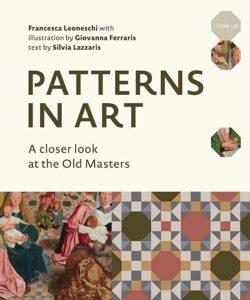
As you wander through an art exhibition, what attracts you to an artwork and makes you linger? Is it color? Subject matter? Technique? While visiting museums together, three friends–Francesca Leoneschi, Giovanna Ferraris and Silvia Lazzaris–discovered they each had a passion for looking at the details in paintings. This shared interest in details that might easily go unnoticed became the impetus for their collaborative book, Patterns in Art: A closer look at the Old Masters.
The primary focus of the book, the authors shared with me via email, would be to “… try to capture something that would less likely be discussed about a painting, but which could add a layer of understanding and invite us to look at a painting from a different perspective.” And that’s what they’ve done: created a details-oriented highlights reel of sorts, with imagery found in Old Masters paintings. It’s not intended to be an art history book or to be used as such. “It’s rather a stimulus, a handbook to make old patterns available today to artists and whoever works with images,” the authors explained.



The authors extracted a number of patterns from the painting Moses and Aaron before Pharaoh. On these pages they recreated the pattern of the red robe and also provided a detail of the pattern within the artwork.
In our email exchange, they noted that one of the project challenges was getting permission to use images of an artwork. As noted in the book’s introduction, they had hoped to include artworks with a broad range of provenances and styles, but were limited to works in museums’ online collections and in the public domain. As such, Patterns in Art focuses on works by Western artists from the 14th to 19th centuries. Within this framework, the authors showcase a selection that “wasn’t at all dictated by the names and fame of the artists or by the medium they used. Instead, it was dictated by the quality of the detail.”
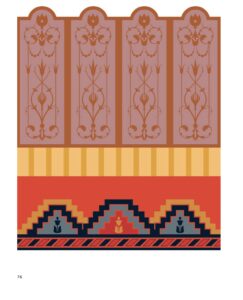

The inclusion of Lilly Martin Spencer is interesting because she’s one of the few female painters in 19th-century America. Like many other combinations in the book, the visual impact of seeing the lyrical botanical pattern from the fabric screen juxtaposed with the bold geometric pattern of the tablecloth to be very thought-provoking.
And what splendid details they are. The book is rich with designs and patterns that run from block-y geometrics to intricate botanical motifs. The patterns are extracted from the floors, walls, backdrops, clothing and decorative objects within the artworks. Some patterns are immediately obvious and others less so, like the bit of delicate trim along a lady’s dress collar or the embroidered design of a lady’s glove. The book’s layout shows a full image of the artwork, sometimes a detail, with supplementary text about the artwork. The highlighted patterns from the artwork are recreated vectorially and enlarged on the facing page. The patterns are shown side by side and in similar scale, regardless of how they might have appeared in the original artwork, “juxtaposing [for example] the pattern of a gown to the pattern of a curtain.” The outcome is an interesting design mix-and-match which allows for some introspection about how colors and patterns interact. It’s an unexpected benefit of the book’s design.
The book is visually-led, with linear patterns loosely alternating with organics, lighter colored motifs followed by more saturated or intricately colored designs. A quick perusal of the visual index at the end of the book–which I loved, by the way, because it’s a mashup of all the book’s patterns–shows the striking variety of color and designs found within this relatively small sampling of artwork. I was taken by the number of patterns I recognized that are still in use today. In our discussion, the authors noted that, in their opinion, the “most surprising patterns were from the Renaissance floors, especially because people back then seemed to be more courageous about color schemes.”
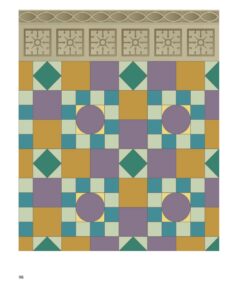
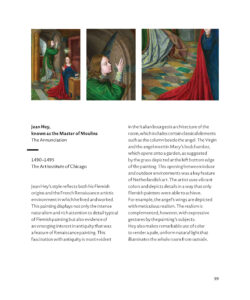
The Annunciation by Jean Hey was included for its lovely patterning. As an additional bonus, it’s an interesting choice because “…a study showed that the use of purple prior to 1863 appeared in approximately 0.06% of the paintings.”
One of the other interesting things the authors discovered in the course of their research is that the “size of the dogs in painting [was] used to convey a very clear idea of gender identity and roles in society… We learned that small dogs were often found in portraits of women and children, whereas men would usually pose with dogs of a bigger size, often hunting dogs.” As I looked through the book I wondered about the history and/or significance of some of the designs and why artists used them. But those are questions to be answered with research outside the purview of this book. Instead, Patterns in Art is an introduction to the motifs these authors–all working in careers related to design and the arts–found fascinating. It’s a glimpse into the way they engage with art “beyond the artist’s brush strokes or use of light.
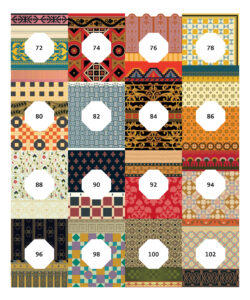
Visual index, showcasing the richness and diversity of patterns highlighted in the book.
Older art should not be seen as something from the past that we admire passively; it’s material that we can draw from in our contemporary endeavors.” Seeing the multitude of designs collected in Patterns in Art, I have to agree. If you’d like to be inspired by Old Masters in a new way and challenged by their creativity, this book is for you.
–Vivien Zepf
- Publisher: Abbeville Press (buy it here)
- Date: November 2019
- ISBN: 9780789213402
If you’ve read this book, leave a comment and let us know what you think!
Do you have a recommendation for a recent fiber-related book you think should be included in SDA’s Book Club? Email SDA’s Managing Editor, Lauren Sinner, to let her know!
